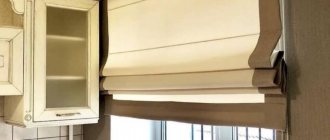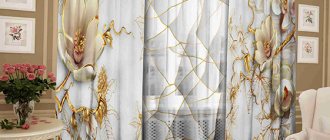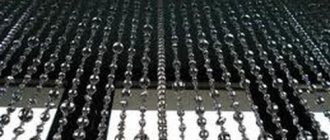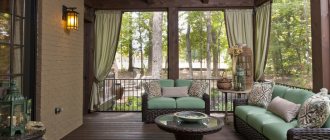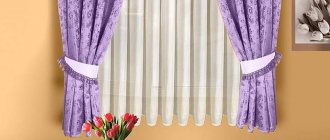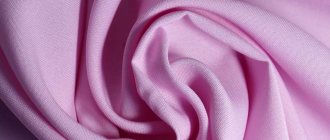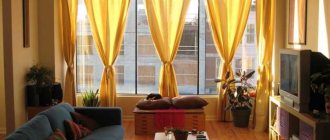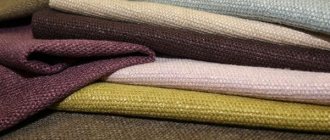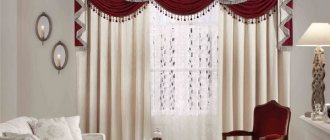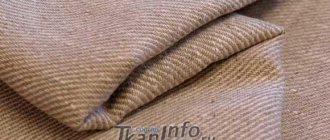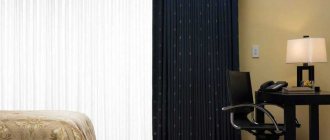Gabardine curtains: main features of the material
Gabardine is a material with a long history. This is a durable, dense and very practical fabric, ideal for sewing curtains. Manufacturing technology and fabric composition may vary. An invariable characteristic feature is the thread weaving system - a complex twill, which gives the material a number of excellent properties.
What fibers does gabardine consist of?
Initially, gabardine was exclusively natural wool fabric. The development of the chemical industry and technological progress have made their own adjustments. Today, the composition of fabrics under the same name can vary greatly. It all depends on what threads were used in production. This also applies to gabardine. Today the following options are available:
- woolen;
- half-wool;
- cotton;
- polyester.
Woolen and wool blend options are more often used for tailoring. Polyester gabardine is ideal for photo printing, which is why it is chosen for photo curtains.
Reference! The name gabardine refers not to the composition, but to the method of weaving the threads - complex twill.
Varieties of gabardine fabrics for sewing curtains: photo examples
Curtain fashion is moving forward. Designers work hard to create new trends and annually replenish the arsenal of catalogs with fresh ideas. The choice of model is a matter of taste and style in which the room is decorated. Below are several ideas.
- For a minimalist style, a simple, strict form of curtains with vertical folds on the eyelets is suitable.
- Combinations with contrasting color inserts are an idea that helps to combine dissimilar interior details in one room.
- Massive floor-length curtains, with complex draperies and fringe, with tassels and a rigid lambrequin with an original edge, will fit perfectly into an elaborate rococo style.
- Ensembles with repetition of accessories made from curtain fabric are good - tablecloths, bedspreads, decorative pillows.
- Multilayer compositions made of thick gabardine curtains and weightless tulles look great.
- Models of photo curtains with tulle companion curtains are an innovative idea.
History and properties of gabardine fabric
Gabardine material differs in manufacturing technique, in particular in the method of weaving the threads. Thomas Burberry is considered its discoverer: it was he who began to invent gabardine production technologies. In the old days, Burberry had his own boutique, where he sold sports and outerwear.
Thomas Burberry decides to create a unique waterproof material. The inspiration came from farmers' clothing, made from thick fabric. Looking at it, Burberry came up with the idea of creating a fabric with an interesting name.
So what is gabardine? Initially, this was the name for the capes of the poor, with which they covered themselves in bad weather. Today, gabardine is a dense, practical material that differs in composition and weave of threads. In particular, the threads are intertwined diagonally, at an angle of 40-60°.
Curtains made from this fabric look very beautiful: the back side has a smooth surface, the front side has a harmonious pattern. Thanks to the special weaving of the threads, the fabric is dense, and it also has water-repellent properties: gabardine does not absorb droplets of water falling on the surface.
You can sew not only curtains and bedspreads. Gabardine fabric is used for sewing sports and specialized clothing. Previously, it was in demand among tourists, athletes and fans of an active lifestyle. During the First World War it was used to sew soldiers' uniforms. It is fair to say that this material can also be used for upholstery of upholstered furniture. At first it was created using merino wool, then flax entered production.
You may also be interested in: Properties of nylon fabric and application for curtains
As for fibers, they are different. Some people prefer fabric made from natural fibers, others buy synthetic ones. A distinctive feature of natural material is the diagonal pattern located on the front side. Synthetic components are visible to the naked eye: the fabric has a characteristic shine. A matte surface indicates the presence of natural fibers.
There are several types of gabardine. Woolen is mainly used for sewing coats. Curtains can be made from gabardine and polyester: this fabric has a smooth surface. In addition, the material varies in thickness: there are thicker and thinner options. It all depends on what threads were used in production. Gabardine has such characteristics as lightness, softness and density.
Advantages of gabardine textiles for windows
Gabardine can be considered an ideal material in all respects for sewing curtains, as well as tablecloths and bedspreads, thanks to which you can create interesting ensembles.
- The complex twill weave makes the fabric dense and gives it water-repellent properties. Droplets of liquid falling on the surface of the canvas roll off faster than they can be absorbed. This property is reliable protection against stains, especially if there are children in the house who can spill something.
- The material allows air to pass through well, which is important in the summer, when at night the windows are open but tightly curtained.
- Wear resistance and durability are undeniable advantages. During the economic crisis, not everyone can afford to change curtains every season. Gabardine curtains completely solve this problem.
Important! Special impregnations protect the product from fading, the appearance of the curtains remains fresh, bright and presentable for a long time. This can be confirmed by those who have gabardine clothes in their wardrobe. A model goes out of fashion before the fabric wears out.
How to choose gabardine curtains
Curtains are one of the most significant elements of the interior. To create them, the style and material are carefully chosen. Properly selected curtain fabric complements the entire interior. Gabardine is often used to sew curtains. This is not a specific material, but a whole group of fabrics, which is united by the characteristic - the presence of scars diagonally across the entire surface of the fabric. Gabardine curtains can have different compositions, densities and types of weaving. The most commonly used are twill and diagonal with thread crossing. Gabardine is a universal fabric, so curtains made from this fabric will be appropriate in any room.
Gabardine curtains: pros and cons
Gabardine curtains are in great demand. They are practical and versatile. Since this material is very dense, it drapes beautifully and forms smooth folds, which makes it stand out from other materials. Given that gabardine fabrics are very dense and have a low specific gravity, hanging them after washing does not cause any difficulties. They tolerate washing well, are durable, hold their shape well and do not lose color when in contact with sunlight. Gabardine allows air to pass through well, so it is not stuffy in a room with curtained windows. Gabardine is often used as the first layer of blackout curtains, since they do not block light well when used once. It is difficult to sew such curtains yourself; it is better to buy gabardine curtains. Washing gabardine curtains is easy; you must take into account the recommendations of the fabric manufacturer.
Types of gabardine fabrics for curtains
The composition of gabardine fabric directly depends on the composition of the fibers from which it is made. There are wool gabardine, which contains only pure wool or half-woolen; it contains fibers of viscose, flax or synthetics. For light interiors, gabardine fabrics made of cotton, silk or synthetics are used, but it must be borne in mind that synthetic gabardine has high tensile strength and does not tolerate sunlight well.
Gabardine for curtains, customer reviews
Many buyers praise gabardine for its durability and its low specific weight. They note the importance of caring for curtains made of gabardine materials. Also, many buyers noted its soft texture and pleasant appearance, but there are reviews that it is somewhat rustic. Many people are unhappy that these curtains let light through and do not completely darken the room. The synthetic type of gabardine is somewhat loose.
The main pros and cons of gabardine curtains
This material has many more advantages than disadvantages. Let's talk about the advantages first.
- Poor stretchability. This means that the curtains will hold their shape perfectly and will not deform during use.
- Wide range of colors. There are many monochromatic options. A variety of shades allows you to choose the material to suit the interior of any room - kitchen, bedroom, living room. Polyester gabardines are perfect for printing. This feature is especially relevant when there is a need to create a certain style using curtains, or to decorate a nursery.
- Easy to process. Even a novice craftswoman can easily sew gabardine curtains. Thick fabric is easy to cut and process.
- Price. Gabardine is a budget material. This does not prevent it from looking modern, stylish, and having a number of advantages.
- Lightness and softness. The density of the material does not increase its weight and does not impair drapability.
The only disadvantage can be considered the low level of light absorption. The leading position in this matter is occupied by blackout matter - it absorbs light by 99%. Gabardine protects the room from light by only 70%.
Advantages of gabardine curtains
The gabardine fabric itself is a woven fabric made of two threads: thin and thicker. Diagonal weaving forms a small textured scar that is visible to the naked eye. Initially, gabardine was made only from merino wool, but later cotton and synthetic materials began to be used. The presence of synthetics in gabardine can be easily determined by the characteristic shine on the fabric. If this is not the case, then the canvas is made from natural raw materials.
Like this, close up in the photo you can see the scar on the fabric
To make sure you make the right choice, read what properties gabardine curtains have.
- Gabardine curtains hold their shape well and drape in even folds.
- Such curtains are easy to wash in a machine and by hand; they will withstand a large number of washes at a temperature of no more than 30-40 degrees.
- They practically do not wrinkle.
- The gabardine fabric itself is not heavy, so hanging such curtains will not be difficult.
- Such curtains do not fade in the sun and do not stretch.
- Despite their density, gabardine curtains allow air to pass through perfectly, and when closed they provide excellent protection from bright sunlight.
- The water-repellent properties of the material allow it to dry quickly after washing.
When sewing gabardine curtains, the fabric frays a lot along the cut edges, which can cause some inconvenience during work.
Gabardine makes elegant curtains with beautifully flowing folds
Gabardine photocurtains: what are they?
Modern digital thermal printing technologies allow you to create entire photo masterpieces on curtains. Blackout, gabardine and satin are ideal “canvases” for printing. The structure of gabardine allows ink to penetrate deeply into the fibers, and fixers and impregnations reliably hold them and protect them from fading.
The print should be chosen in accordance with the style in which the room is decorated. Fortunately, there is no shortage in this regard today. Stripe for Provence, check for country; portals, columns, terraces with peacocks - classics. Favorite cartoon characters - an idea for a nursery; juicy, luxurious 3D masterpieces - in the living room. Photocurtains can be purchased ready-made or made to order.
Features of caring for gabardine window textiles
The material does not require special handling or expensive, delicate cleaning products. The fabric does not fade and is abrasion resistant. But this does not mean that there are no special care features at all. Labels usually use a number of symbols with the rules for using textile products, and curtains are no exception. The icons indicate the temperature conditions for washing and ironing, explain how to properly dry the product and what products to use. Following the manufacturer's advice will extend the life of your curtains.
Probability of washing
Washing gabardine curtains will not cause much trouble.
- Products made from natural wool fiber should be washed by hand at 30°C, or better yet dry cleaned. Synthetic options - at 40 °C.
- Hand washing is preferable without twisting, machine washing is allowed - in the “Synthetic” and “Delicate Wash” modes, also without spinning. Gabardine is not subject to deformation, but hanging it without first twisting it will eliminate the need to iron the material.
- If you decide to machine wash, you should not pack the drum tightly with curtains. The best option is to fill it halfway.
Reference! This fabric is often used for sewing tablecloths and curtains in catering establishments, as well as for uniforms for cooks and waiters. Restaurant owners and staff note the excellent characteristics of the fabric in terms of ease of removing stains.
- It is important to rinse the product well to avoid white streaks.
- Do not dry in direct sunlight.
How to store products
For those who strictly follow the fashion of curtains and change them according to the season, the issue of storing the accessory is especially relevant. The storage process is simple.
- General wash before storing. You should not store curtains dirty. After several months of staying in the closet, the dirt will be firmly ingrained into the material.
- Neat folding and storage in the closet.
- Shaking and, if necessary, ironing upon removal from the cabinet.
- Ironing. In principle, gabardine is a low-wrinkle material. But if there is a need to iron the product, this should be done only from the wrong side at medium temperature, with steam or moisturizing from a spray bottle. Before you begin ironing, it is important to test the temperature of the iron on an inconspicuous area, for example, the bottom corner of a curtain.
- The last stage is hanging and airing. To ventilate the curtains, you need to open the window, draw the curtains and leave them in this state for a while.
Reference! Ironing the material from the front side leads to the formation of lass (unwanted shine).
What is better padding polyester or holofiber?
Siliconized padding polyester
Rules of care and selection
Gabardine fabric does not require special care, but if you bought a product made from it, such as curtains, you need to take into account the manufacturer's recommendations. High-quality fabric retains its shape after washing, but you should choose the right temperature. In general, this material does not fade or tear. If you bought a product made from natural wool, wash it at 30°C. If synthetic additives are present, use water at a temperature of 40°C. To maintain matteness, follow a simple rule: iron the product from the wrong side, covering it with gauze.
You may also be interested in: Naturalness and advantages of chiffon fabric
There is a wide range of products on sale. The fabric differs in cost and quality characteristics. Imported ones, made from natural materials, are more expensive; fabric with synthetic additives is cheaper. Beginning seamstresses buy synthetics: they are very convenient to use. The most affordable of all is considered to be Chinese-made material: cheap synthetic fibers are usually added to the composition.
Curtains made of gabardine will look stylish, moreover, they will be inexpensive. If desired, you can create a composition using frill. Such original curtains will definitely not go unnoticed!
Save
Save
Save
Save
